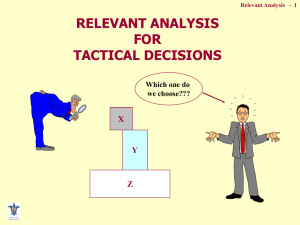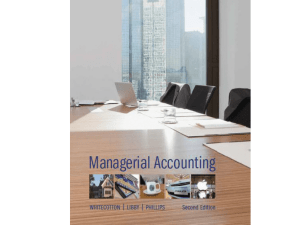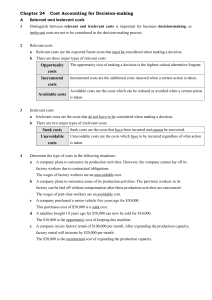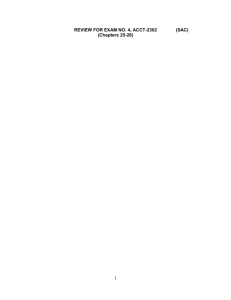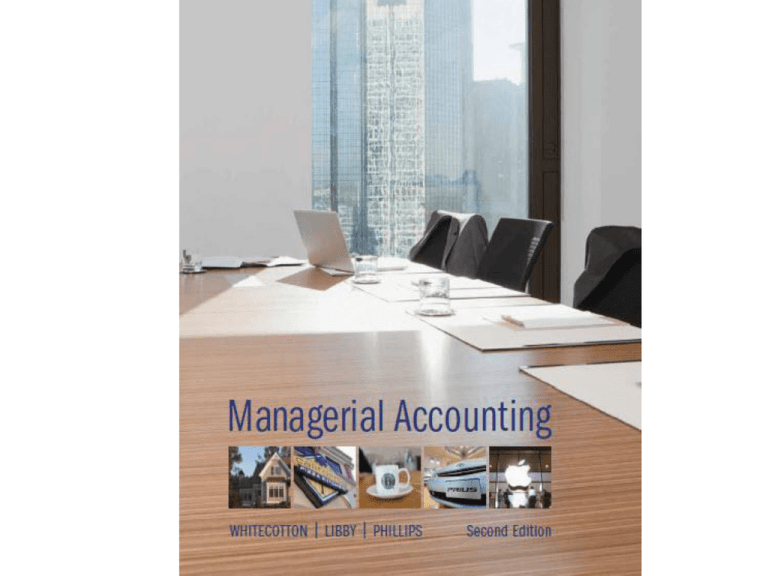
Chapter 7
Incremental Analysis for Short-Term Decision Making
PowerPoint Authors:
Susan Coomer Galbreath, Ph.D., CPA
Charles W. Caldwell, D.B.A., CMA
Jon A. Booker, Ph.D., CPA, CIA
Cynthia J. Rooney, Ph.D., CPA
McGraw-Hill/Irwin
Copyright © 2014 by The McGraw-Hill Companies, Inc. All rights reserved.
Steps in the Decision-Making Process
7- 3
Relevant versus Irrelevant Costs
and Benefits
Relevant Costs have the potential
to influence a decision.
Two Criteria for a Relevant Cost
1. Occurs in the future
2. Differs between decision alternatives
Relevant costs are also called
differential costs, incremental
costs, or avoidable costs.
7- 4
Relevant versus Irrelevant Costs
and Benefits
Irrelevant costs are those that will
not influence a decision.
Costs that have been
incurred in the past.
(sunk costs)
Costs that are the
same regardless of the
alternative chosen.
7- 5
Opportunity Costs and Capacity
Considerations
An opportunity cost is the benefit that is
given up when one alternative is selected
over another.
At full capacity, adding
additional work requires
giving up a portion of
the existing work. The
benefit of the existing
work given up is an
opportunity cost.
With idle capacity,
additional work may be
added without
sacrificing existing work.
There is no opportunity
cost to the additional
work.
7- 6
Special-Order Decisions
A special order is a one-time
order that is outside the scope
of normal sales.
When analyzing a special
order, only the incremental
costs and benefits are relevant.
7- 7
Special-Order Decisions
A major university has asked Mattel to make a special
University Barbie, dressed in a sporty outfit with the
school’s logo and colors. The university bookstore has
offered to buy 25,000 of these dolls at a price of $7.00
each. Mattel has the capacity to fill the order without
affecting production of other Barbie products, which
are normally sold to toy stores and discount chains for
$9.00 each.
More Information
7- 8
Special-Order Decisions
Mattel estimates that its unit cost to produce the
University Barbie will be:
Should Mattel accept the special order?
7- 9
Incremental Analysis (with Excess
Capacity)
The special order
will result in a
profit of $2.00
per doll and a
total profit of
$50,000. Note
that fixed costs
are excluded
because they are
irrelevant to the
decision.
7- 10
Make-or-Buy Decisions
A decision to perform a particular activity or
function in-house or purchase from an outside
supplier has traditionally been called a make-orbuy decision, but could also be called an
insourcing versus outsourcing decision.
Key Questions
1.What costs will change?
2.Are there opportunity costs
associated with either alternative?
3.Are there other qualitative factors to
consider?
7- 11
Decisions to Keep-or-Drop Segments
Managers must sometimes decide whether to
eliminate a particular division or segment of the
business. These decisions are called keep-or-drop
decisions or continue-or-discontinue decisions.
Key Questions
1.How much will total revenue and total costs
change?
2.Will other segments or product lines be affected?
3.Are there opportunity costs associated with
keeping the segment?
4.Are there other qualitative factors to consider?
7- 12
Sell-or-Process Further Decisions
Businesses are often faced with the decision
to sell a product “as is” or refine it so that it can be
sold for a higher price.
As a general rule, we process
further only if incremental
revenues exceed incremental
costs.
Costs of manufacturing the
product up to the sell-orprocess decision point are
sunk and therefore irrelevant.
7- 13
Summary of Incremental Analysis
Common Rules for Analyzing Relevant Costs and Benefits:
• Relevant costs and benefits occur in the future and differ between
alternatives.
• Variable costs are usually relevant to the decision because they
vary with the number of units produced or sold.
• Fixed costs may not be relevant because they do not change with
the number of units produced or sold. Fixed costs that are directly
related to the decision may be avoidable and thus relevant.
• Opportunity costs are the lost benefit of choosing one alternative
over another. These costs are relevant and occur when capacity is
reached or resources are constrained.
• The quantitative analysis provides a starting point for making
decisions, but must be balanced against qualitative factors such as
quality considerations, customer loyalty, and other factors.
7- 14
Prioritizing Products with Constrained
Resources
When a limited resource restricts a company’s ability to
satisfy demand, the company is said to have a constrained
resource that is referred to as a bottleneck.
To maximize profits in the short run, a company with a
bottleneck must prioritize its products or services so as
to maximize contribution margin per unit of the
constrained resource.
The focus is on contribution margin because fixed costs
will not change in the short run, and are not relevant.
7- 15
End of Chapter 7
7- 16


